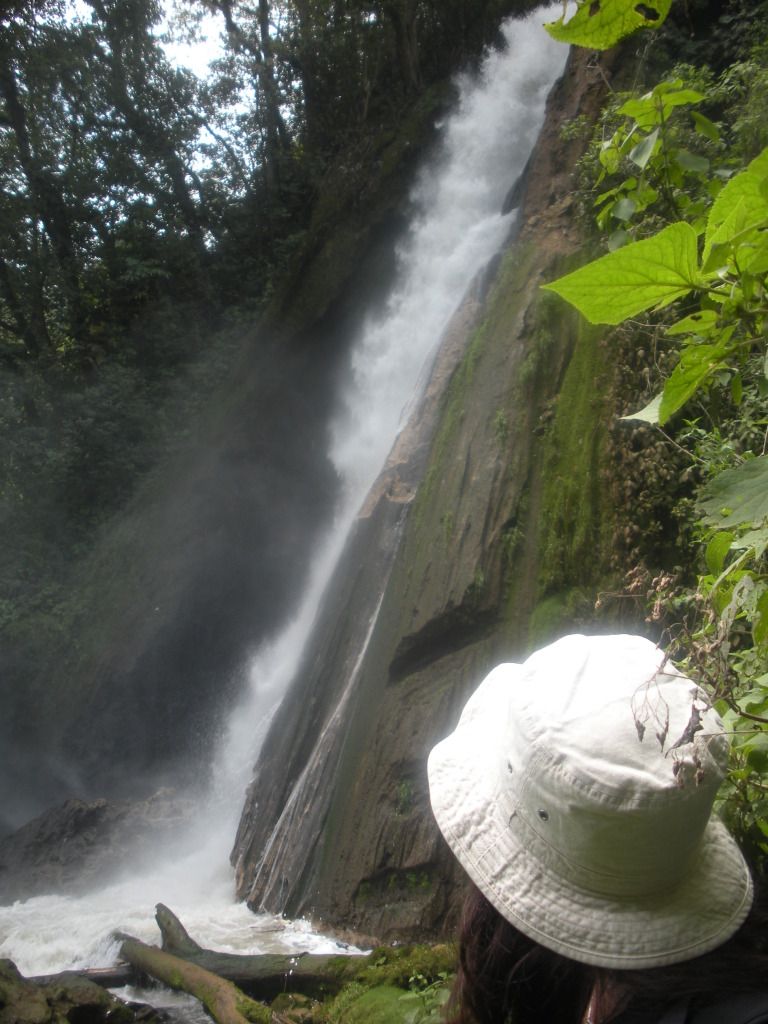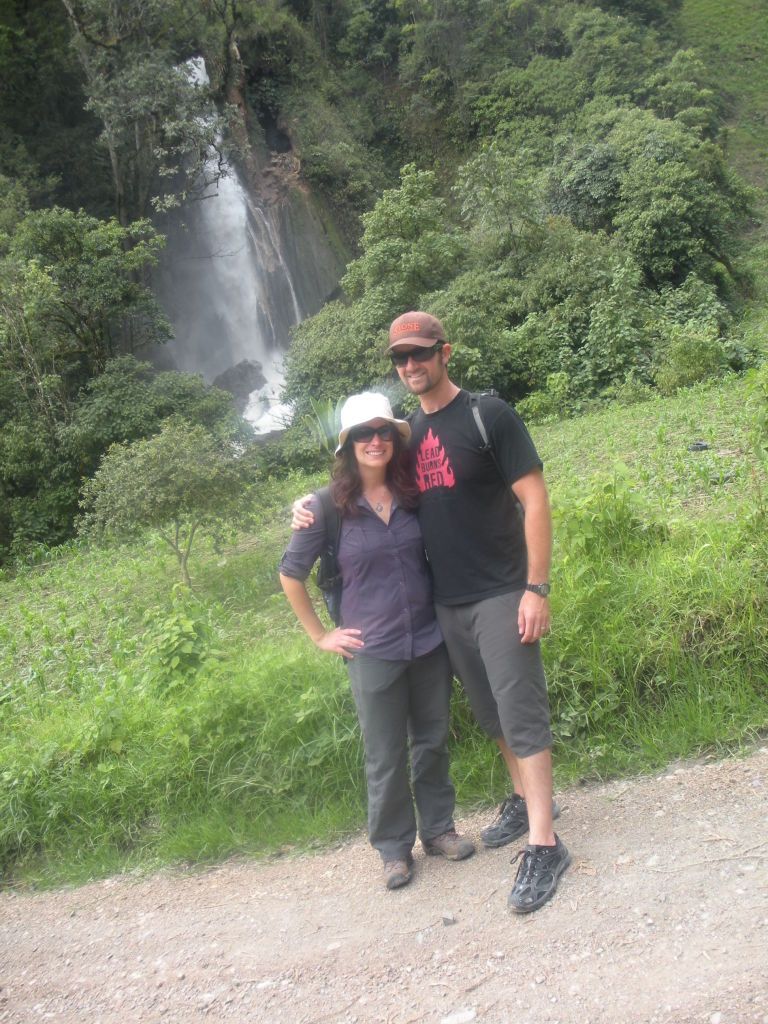Caminante, No Hay Camino
NEBAJ, GUATEMALA: July 11-12
Steve: My body has
not been liking this traveling-in-a-developing-country thing. Our last night in
Chichicastenango was highlighted by a sleepless night of bad chills, fever and
headache. After feeling the fever pass about 6 in the morning, I knew I wanted
to get a move on and make it to our next destination so that I could relax (Leah: Nothing like having your husband
wake you up at 4:30 a.m. feverish and desperate for safe drinking water only to
suffer complete panic when I realized our water bottles were empty and the only
other option would be thirst or unsafe tap water. Luckily we had an angel that
night and found a water bottle we had forgotten about in our daypack. Just
another example of how we don’t always realize how lucky we are to turn on the
faucet when needed). We trekked to the camioneta
station where we proceeded to take the next bus out of town to Nebaj. Let’s
just say that poorly-maintained roads, multitudinous speed bumps, mountainous
switchbacks and a tired, achy head do not go well together. I toughed it out
though and we made it to our next stop, the alpine village of Nebaj.
About a half hour prior to entering Nebaj we could feel a
drastic—and welcome—change in the temperature as this town is nestled in some
of Guatemala’s highest country. The town itself is not unlike many of the other
towns that we had already visited—a busy central park, colorful tiendas and a small but bustling market,
all juxtaposed with unpaved roads, dilapidated (or maybe just unfinished)
buildings and lots of street dogs. (Speaking of street dogs, I’ll make a quick
digression here—this is partly my blog so you don’t have a choice!—a majority
of the dogs seem to be rather well fed, although as we’ve witnessed it is due
to their ingenuous adaptation to life on the street; the basic instinct for
survival will do that. The farther out of major cities that we’ve gone it’s
clear that sterilizing dogs is not a priority and/or the infrastructure to
support that are not in place (we’ve seen hardly if any cats, go figure). Most
of you probably know that I spent a good deal of time volunteering with the
county shelter in San Diego, so seeing so many good looking and well behaved
pups has been rather difficult. But as a passerby, there’s really not so much I
can do, right? Except go back in time and study to be a veterinarian…but again,
I digress.)
Where was I? Nebaj, right. So after arriving in the packed,
diesel-exhaust-ridden bus station (which had a dog that looked ridiculously
like Minger and stopped us both in our tracks as we tried to exit the bus) we
made our way down several blocks to the first hostel that our guide book
suggested. After viewing the available room, I couldn’t agree to stay there
even in my fatigued state. Luckily Leah, who for all intents and purposes is
the guardian of our budget (I probably would have gone all out a couple of
times already), felt the same way so we moved on a couple of blocks and
stumbled upon another hostel, Hotel Media Luna Medio Sol. This place which was
started by an American Peace Corp volunteer is by no means fancy—as Leah
pointed out there’s probably no Ritz Carlton Nebaj—but felt much more comfortable
and seemed like a better place from which to explore the town. Additionally
funds from the hostel and associated restaurant and tour agency go directly to
supporting the local Ixil community. Nevertheless we ate at the restaurant and
booked a half-day tour for the following day to see some local waterfalls.
After being fat and happy, feeling like we had done a good deed, and watching a
Spanish version of The Transporter 3
(without subtitles), we took to our bunk beds and got a good night’s sleep. (Leah: Well, after I had a coughing fit
and wanted to claw my eyeballs out due to my allergic reactions to the
just-a-tad moldy room).
The next day we got an early start so that we could have a
nice breakfast prior to our hike. We found a local comedor where we got delicious egg, bean and rice plates for the
equivalent of a couple US dollars. Leah even had her first cup of coffee as the
black coffee that I thought I asked for turned out to be doused with a couple
spoonfuls of sugar, making it so sweet that my princess of a wife actually
liked it (Note to self—be more explicit when you ask for coffee). We then
headed back to the hostel to meet up with our tour guide, Nicolas, a local who
speaks both Spanish and Ixil—the language of the indigenous population in this
part of Guatemala. Guide book or not, there’s no way that we would have found
these waterfalls without his help. After guiding us out of the town we veered
off onto a small dirt trail that hugged a river which has multiple names,
neither of which I can remember now. We trekked through some much smaller
communities, many of which appeared to only speak the Ixil language, so it was
good to have a guide that spoke their language and apparently knew everyone
everywhere. We passed many fields of corn, saw quite a few cattle roaming
freely and generally stayed close to the river as we made our way towards our
destination. (Leah: And of course I
shrieked with delight at all the baby things—clucking chicks, piglets so small
they could fit in your hand, lazy eyed calves and squirmy puppies. We don’t
have much farmland nature in San Diego!)
At one point, Leah asked our guide about the issue regarding
hydroelectric power and this river as we had seen multiple
signs/propaganda/tagging that called for no hydroelectric power and to save the
environment. To be quite honest, I’m not really sure what the full details on
this issue are and I’m pretty sure Leah doesn’t know either. Our guide started
to ramble on softly and coupled with the white-water rapids to the right of us
we could only make out bits and pieces of his discourse. All I can tell you is
that it’s an issue. I bring this up however as I wanted to segue into the irony
of these signs which called for saving the environment. As lovely as the river,
waterfalls and overall scenery were, the most outstanding feature was the
amount of trash that makes it into this seemingly pristine water source. We
have many great pictures that we took of this hike however many were
strategically taken at angles so as not to spoil the photo with plastic
bottles, tires or other debris. Leah had brought up a good point that she
learned in her Peace Corp days—yes, there may be signs everywhere about putting
trash in its place and to care for the environment, but without a solid
infrastructure to support this how do you really instill this idea into the
local population? To be sure, there is no curbside trash pick-up and there
aren’t any dumpsters around the corner. This would require an influx of money
that a developing country just doesn’t have (or is pilfered by corrupt
government officials, but that is another topic for another day). It also got
me thinking that for the indigenous population, littering might not have been
so bad hundreds of years if not decades ago. Trash must have consisted of corn
husks, food leavings and other biodegradable material. Nowadays
industrialization has brought plastics and other packaging to their proverbial
doorstep. A bottle of soda is cheap, infrastructure is not—so the rhetorical
question of how to address the problem will stand unanswered.
My ramblings about humanitarian problems aside, Nebaj was an
overall beautiful place and I am glad that we took the time to explore it a bit
further. We did walk through some public farmland that was borderline idyllic
and greeted the indigenous people who for better or worse have lives that are
far simpler than the ones we have back at home in the States. That said I am
looking forward to our next destination which will take us to Semuc Champay, a
national park that promises to give us a glimpse of some of the most untouched
natural beauty that Guatemala has to offer.
CLICK HERE FOR MORE PICTURES.
CLICK HERE FOR MORE PICTURES.




Se hace camino al andar
ReplyDeleteAl andar se hace camino, y cuando se ve la senda atrás
ReplyDeletese ve la senda que nunca se ha de volver a pisar
ReplyDelete